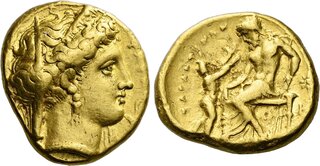| Numismatica Ars Classica > Auction 146 | Auction date: 8 May 2024 |
| Lot number: 2021 Price realized: This lot is for sale in an upcoming auction - Bid on this lot  | Show similar lots on CoinArchives Find similar lots in upcoming auctions on |
| Lot description: Calabria, Tarentum. Stater circa 333-331/0, AV 17 mm, 8.52 g. T[APA] Veiled and diademed head of Hera r., wearing earring and necklace; below chin, dolphin swimming downwards. Behind neck, [E]. Rev. TAPANTINΩN Young Taras standing r., raising hands in supplication to Poseidon seated l., leaning forward and holding trident; in field r., star / T. Below stool, diphros and K. Vlasto 1 (these dies). de Luynes 241 (these dies). AMB 89 (these dies). Kraay-Himer pl. X, 315 (this reverse die). SNG France 1777 (these dies). Jenkins Essays Thompson, pl. 10, 13 and 19 (these dies). Fischer-Bossert G5. Historia Numorum Italy 901 (these dies). Extremely rare. A portrait of superb style and a reverse composition of great beauty and fascination, one of finest representations on a Greek coin. Minor marks, otherwise good very fine Ex NAC 48, 2008, 3; Nomos 6, 2012, 3 and CNG 97, 2014, 6 sales Of all the coins of Tarentum, this gold stater perhaps elicits the greatest praise for the skill and ingenuity of the engraver. The composition is masterful, and one can only imagine how this would have looked on the grand scale of a statuary group. Beyond the composition, we may revel in the quality of the engraving, which breathes life into a scene that otherwise might appear stiff and formal. The artist treats us to nothing less than an impassioned plea of young Taras to a towering, but caring figure of Poseidon, who considers the proposal. A coin type of such a highly personal nature demands a tie to history. Various opinions have been offered, which help to narrow the possibilities down to the period 342 to 330 B.C. The two events in this era that could have prompted this coinage are interventions in Southern Italy on behalf of the Tarentines by Archidamus of Sparta in 342 and Alexander the Molossian, whose more enduring (but no less disastrous) campaign began in 334. Robinson prefers the former, interpreting the scene as an allusion to the plea of Taras to its mother city Sparta. Other scholars prefer the latter, associating the coinage with Alexander, especially since the thunderbolt symbol is prominent. Robinson argues that the thunderbolt need not be taken as a certain allusion to Alexander, as it is a common symbol, and that the type is more appropriate to the relationship between colony and mother city. Though the obverse generally is not the focal point of this coinage, it is worth noting that the beautiful female head – usually described as Persephone – may actually be Hera. In particular, her stephane is decorated with palmettes in a manner identical to that worn by Hera on the staters of Elis. Also of interest is the fact that the inscription TAPA before her face has generally been missed by researchers: Robinson only hinted at what appeared to be portions of the inscription on the Gulbenkian example, though we are fortunate that Rutter, in his recent Historia Numorum Italy, includes it in his description of the type. Estimate: 40000 CHF |  |



